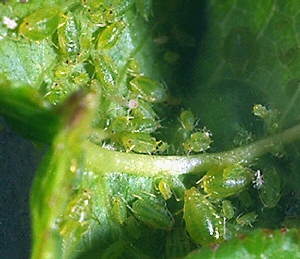Green Peach Aphid
 Scientific Name
Scientific Name
Myzus persicae
Hosts
The green peach aphid infests a very wide range of plants, especially under greenhouse conditions. Some important hosts include cabbage and related cole crops, dandelion, endive, mustard greens, parsley, turnip, tomato, tobacco, potato, spinach, pepper, beet, celery, lettuce, and chard.
Symptoms
 Green peach aphids extract sap from plants and excrete a sweet sticky substance known
as honeydew. Black sooty mold grows on honeydew and, though not directly harming the
plants, may block out sufficient light to reduce yield. Weakened plants become susceptible
to other insects and diseases and may be inoculated with viruses carried by the aphids.
Among the virus diseases transmitted by green peach aphids are potato leaf roll, potato
virus Y, beet mosaic, beet yellows, and lettuce mosaic.
Green peach aphids extract sap from plants and excrete a sweet sticky substance known
as honeydew. Black sooty mold grows on honeydew and, though not directly harming the
plants, may block out sufficient light to reduce yield. Weakened plants become susceptible
to other insects and diseases and may be inoculated with viruses carried by the aphids.
Among the virus diseases transmitted by green peach aphids are potato leaf roll, potato
virus Y, beet mosaic, beet yellows, and lettuce mosaic.
Life Cycle
Adults pass the winter on greens and wild hosts such as spinach, collards, turnip, wild mustard, and dock. Winged forms migrate to other hosts in late spring. During these migratory flights, aphids may spread virus diseases from infected volunteer plants and weeds to healthy crop plants. Movement between host plants continues through summer and fall. Successive generations of females, mainly wingless, are produced throughout the year. Winged migrants develop whenever overcrowding occurs or food becomes scarce. Outdoor infestations are most common during the spring and fall and decline during the hottest months of the summer. This aphid is also a very common pest in greenhouses, where it breeds continuously. Many generations are produced each year.
Description
This soft bodied, pear-shaped insect is usually wingless and about 1/16 inch long. The wingless female is pale yellow green. The winged migrant form has a yellowish green abdomen with a dark dorsal blotch. Both forms have a pair of tailpipe-like appendages known as cornicles. Nymphs are smaller than adults but similar in shape. They are pale yellow green with three dark lines on the abdomen. All stages can be recognized by the shape of the frontal tubercles (on the front of the head at the antennal bases). In dorsal view these tubercles are strongly developed (gibbose) and converge anteriorly.
Control
Please contact your local county extension office for current information.
